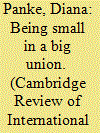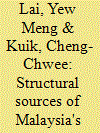|
|
|
Sort Order |
|
|
|
Items / Page
|
|
|
|
|
|
|
| Srl | Item |
| 1 |
ID:
117856


|
|
|
|
|
| Publication |
2012.
|
| Summary/Abstract |
Compared with bigger states, smaller states have fewer votes, less economic power, fewer administrative resources and less staff and experts. This leads to disadvantages in negotiations. Yet smaller states can concentrate their limited resources on issues of great importance and can-under certain conditions-punch above their weight. This is especially effective if small states use their ideational resources in applying different argumentative strategies. Each strategy is only effective under certain scope conditions. The vodka and the pesticides cases illustrate that active small states can punch above their weight if they make arguments that fit the nature of the issue and resonate well with prior beliefs of the addressees of the arguments. A regulatory issue that is technical in nature, such as the pesticides case, requires good scientific arguments. A political issue with prevalent distributive effects, such as the vodka case, calls for normative arguments to persuade neutral actors and the re-framing of the distributional elements into common-good questions to talk actors with opposing preferences into acceptance.
|
|
|
|
|
|
|
|
|
|
|
|
|
|
|
|
| 2 |
ID:
178855


|
|
|
|
|
| Summary/Abstract |
This essay traces the structural sources of Malaysia's South China Sea policy. It argues that Malaysia's ‘light-hedging’ approach is primarily a smaller-state's response to growing systemic pressure arising from power asymmetry, rivalry, and uncertainties. The features of this approach are: an insistence on not taking sides, concurrent adoption of open deference and indirect defiance, and an active effort to cultivate a fallback position, all aimed at reducing multiple risks associated with the uncertainties of US commitment , China's long-term intentions, and their future relations. We have arrived at three main findings. First, structural impact matters: as geopolitical uncertainty increases, weaker states hedge more deeply. Second, smaller states do have agency, even if only in a low-profile manner. Because smaller states have been disadvantaged under an asymmetric power structure, they often use a combination of diplomatic, legal, developmental, and defence means to shape favourable external conditions. Third, while hedging is chiefly a result of structural factors, the forms and degree of a state's hedging activism are necessarily a function of its threat perceptions, elite interests and other unit-level variables. These factors explain Malaysia's light form of hedging: quiet action and limited defiance alongside open accommodation in managing the South China Sea disputes.
|
|
|
|
|
|
|
|
|
|
|
|
|
|
|
|
| 3 |
ID:
177652


|
|
|
|
|
| Summary/Abstract |
This essay offers a small state perspective on US-China rivalry
in the post-COVID-19 era. After tracing the emergence of
the “twin chessboards” of big power rivalry, namely, high
and low politics competitions, the essay assesses the impact
of these competitions on the post-pandemic Asian order,
with a focus on Southeast Asia. I argue that while US-China competition has been rising rapidly in high politics (that
is, in the military field), the increasing importance of low
politics—infrastructure and connectivity development, technology, trade, finance, public health, and other functional
areas—is shaping the prospects, pace, and patterns of the
onset of Cold War 2.0. The intensified US-China animosity
across the twin chessboards is widening the scope of the
competition, increasing the number of players, and mounting pressure on all smaller states. Arguably, however, it is
also providing these smaller states with more maneuvering
space. These developments reshape geostrategic supply and
demand in Southeast Asia. Accordingly, the smaller states
are developing additional layers of partnerships with actors
near and far, thereby broadening their hedging options in
an increasingly uncertain and high-stake environment.
|
|
|
|
|
|
|
|
|
|
|
|
|
|
|
|
|
|
|
|
|